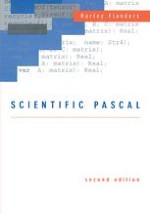1996 | Buch
Über dieses Buch
Guide to this Book My main objective is to teach programming in Pascal to people in the hard sciences and technology, who don't have much patience with the standard textbooks with their lengthy, pedantic approach, and their many examples of no interest to scientists and engineers. Another objective is to present many both interesting and useful algorithms and programs. A secondary objective is to explain how to cope with various features of the PC hardware. Pascal really is a wonderful programming language. It is easy to learn and to remember, and it has unrivalled clarity. You get serious results in short order. How should you read this book? Maybe backwards is the answer. If you are just starting with the Borland Pascal package, you must begin with Appendix 1, The Borland Pascal Package. If you are a Pascal user already, still you should skim over Appendix 1. Appendix 2, On Programming, has material on saving programming time and on debugging that might be useful for reference. Chapter 1, Introduction to Pascal, will hardly be read by the experienced Pascal programmer (unless he or she has not used units). Chapter 2, Programming Basics, begins to sample deeper waters, and I hope everyone will find something interesting there. Chapter 3, Files, Records, Pointers, is the final chapter to concentrate on the Pascal programming language; the remaining chapters concentrate on various areas of application.
Anzeige
